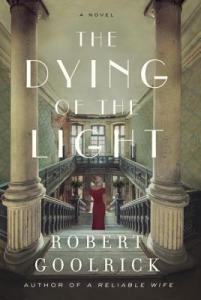
Book Cover Image: The Dying of the Light by Robert Goolrick
" data-orig-size="268,400" sizes="(max-width: 201px) 100vw, 201px" aperture="aperture" />BOTTOM LINE: Good but not his best
Genre: Historical Fiction
Publication Date: 3 July 2018
Source: Publisher via Edelweiss
Synopsis from the Publisher:
“Diana Cooke was ‘born with the century’ and came of age just after World War I. The daughter of Virginia gentry, she knew early that her parents had only one asset, besides her famous beauty: their stately house, Saratoga, the largest in the commonwealth, which has hosted the crème of society and Hollywood royalty. Though they are land-rich, the Cookes do not have the means to sustain the estate. Without a wealthy husband, Diana will lose the mansion that has been the heart and soul of her family for five generations.
The mysterious Captain Copperton is an outsider with no bloodline but plenty of cash. Seeing the ravishing nineteen-year-old Diana for the first time, he’s determined to have her. Diana knows that marrying him would make the Cookes solvent and ensure that Saratoga will always be theirs. Yet Copperton is cruel as well as vulgar; while she admires his money, she cannot abide him. Carrying the weight of Saratoga and generations of Cookes on her shoulders, she ultimately succumbs to duty, sacrificing everything, including love.
Luckily for Diana, fate intervenes. Her union with Copperton is brief and gives her a son she adores. But when her handsome, charming Ashton, now grown, returns to Saratoga with his college roommate, the real scandal and tragedy begin.
Reveling in the secrets, mores, and society of twentieth-century genteel Southern life, The Dying of the Light is a romance, a melodrama, and a cautionary tale told with the grandeur and sweep of an epic Hollywood classic.”
My Thoughts: Done well, historical fiction brings a period of history back to life with crystal clarity. It allows you to experience a time period outside of pictures, silent films, and documents and maybe learn a little something in the process. Unfortunately, The Dying of the Light is only a good example of why I love historical fiction. While details exist in multitude, there remains something a little otherworldly about Mr. Goolrick’s latest novel that hinders the time period experience and a lack of character development that prevents it from being a great example of one.
The Dying of the Light does have its shining moments in spite of its faults. Mr. Goolrick excels at capturing historical detail. His exquisite attention to even the most minute element of the setting is perfect for the fading grandeur of Saratoga, its grounds, and its legacy. So too is the timeframe of the novel. Set at the turn of the century, there can be no other time period that befits the opulence of the Coppertons, the Cookes, and their entire milieu.
Where the story is lacking, in my opinion, is in the characters. Outside of Diana, the rest of the cast are little more than caricatures. There is an attempt to flesh them out a bit, but the attempts fall flat in most cases. The husband remains the loutish brute who takes what he wants whenever he wants. There is something desperate, almost incestual about Diana’s relationship with her son, while her relationship with her son’s best friend succeeds in taking the story to a different level. However, even there, in this formative relationship that finally sets the plot into motion, the connection between Diana and him remains nebulous. In essence, there is just not enough detail about the characters and their connections to mirror the volume of detail we receive about the house, traditions, or Diana’s clothes, and the disparity highlights the weaknesses within the story.
The thing is that I really enjoyed reading The Dying of the Light and would consider it a good novel. Then I read another historical fiction novel and realized how lacking in some areas the story truly is. I had already recognized the issues with the characters, but the story itself is also a bit too tepid. Nothing really happens until the end of the novel, even though the lavish setting and attention to detail on the material things makes you feel as if something more should happen.
Until I finished reading that second historical fiction novel so soon after finishing this one, this review was building up to be completely different because I did enjoy it at the time. It is just that my college comparative literature class seems to have stuck with me two decades later, and I cannot help but compare one to the other no matter how unfair that may be. Then again, I do not think The Dying of the Light is Mr. Goolrick’s best novel; I would save that title for one of his previous novels. So, perhaps no comparison is necessary after all, and the novel is exactly what I said at the very beginning. It is only a good example of the historical fiction genre. There are other novels, including one of Mr. Goolrick’s previous novels, that are much better examples of fantastic historical fiction.
